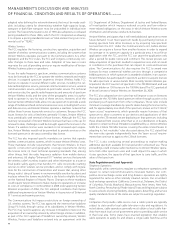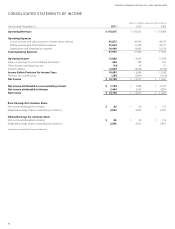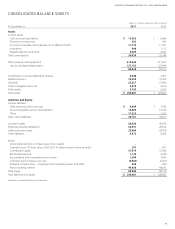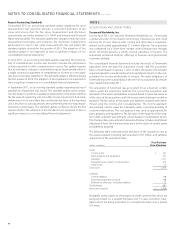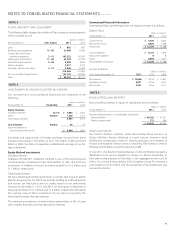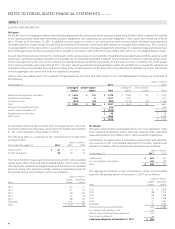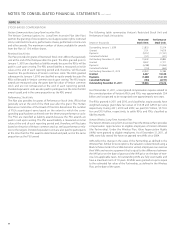Verizon Wireless 2011 Annual Report Download - page 60
Download and view the complete annual report
Please find page 60 of the 2011 Verizon Wireless annual report below. You can navigate through the pages in the report by either clicking on the pages listed below, or by using the keyword search tool below to find specific information within the annual report.nOtEs tO cOnsOlidatEd Financial statEMEnts continued
58
Intangible Assets Not Subject to Amortization
A significant portion of our intangible assets are wireless licenses that
provide our wireless operations with the exclusive right to utilize des-
ignated radio frequency spectrum to provide cellular communication
services. While licenses are issued for only a fixed time, generally ten years,
such licenses are subject to renewal by the Federal Communications
Commission (FCC). Renewals of licenses have occurred routinely and at
nominal cost. Moreover, we have determined that there are currently no
legal, regulatory, contractual, competitive, economic or other factors that
limit the useful life of our wireless licenses. As a result, we treat the wireless
licenses as an indefinite-lived intangible asset. We reevaluate the useful
life determination for wireless licenses each year to determine whether
events and circumstances continue to support an indefinite useful life.
We test our wireless licenses for potential impairment annually or more
frequently if indications of impairment exist. We evaluate our licenses
on an aggregate basis using a direct value approach. The direct value
approach estimates fair value using a discounted cash flow analysis to
estimate what a marketplace participant would be willing to pay to pur-
chase the aggregated wireless licenses as of the valuation date. If the fair
value of the aggregated wireless licenses is less than the aggregated car-
rying amount of the licenses, an impairment is recognized.
Interest expense incurred while qualifying activities are performed to
ready wireless licenses for their intended use is capitalized as part of
wireless licenses. The capitalization period ends when the development
is discontinued or substantially complete and the license is ready for its
intended use.
Intangible Assets Subject to Amortization
Our intangible assets that do not have indefinite lives (primarily customer
lists and non-network internal-use software) are amortized over their
useful lives and reviewed for impairment whenever events or changes
in circumstances indicate that the carrying amount of the asset may
not be recoverable. If any indications were present, we would test for
recoverability by comparing the carrying amount of the asset to the net
undiscounted cash flows expected to be generated from the asset. If
those net undiscounted cash flows do not exceed the carrying amount,
we would perform the next step, which is to determine the fair value
of the asset and record an impairment, if any. We reevaluate the useful
life determinations for these intangible assets each year to determine
whether events and circumstances warrant a revision in their remaining
useful lives.
For information related to the carrying amount of goodwill by segment,
wireless licenses and other intangible assets, as well as the major com-
ponents and average useful lives of our other acquired intangible assets,
see Note 3.
operations are retired or otherwise disposed of, the related cost and
accumulated depreciation are deducted from the plant accounts, and
any gains or losses on disposition are recognized in income.
We capitalize and depreciate network software purchased or developed
along with related plant assets. We also capitalize interest associated with
the acquisition or construction of network-related assets. Capitalized
interest is reported as a reduction in interest expense and depreciated as
part of the cost of the network-related assets.
In connection with our ongoing review of the estimated remaining
average useful lives of plant, property and equipment at our local tele-
phone operations, we determined that there were no changes necessary
to average useful lives for 2011 and 2010. We determined effective
January 1, 2009 that the average useful lives of fiber cable (not including
undersea cable) would be increased to 25 years from 20 to 25 years and
the average useful lives of copper cable would be changed to 15 years
from 13 to 18 years. These changes to average useful lives did not have
a significant impact on depreciation expense. In connection with our
ongoing review of the estimated remaining average useful lives of plant,
property and equipment at our wireless operations, we determined that
changes were necessary to the remaining estimated useful lives as a
result of technology upgrades, enhancements, and planned retirements.
These changes resulted in an increase in depreciation expense of $0.4
billion in 2011, and $0.3 billion in 2010 and 2009, respectively. While the
timing and extent of current deployment plans are subject to ongoing
analysis and modification, we believe the current estimates of useful lives
are reasonable.
Computer Software Costs
We capitalize the cost of internal-use network and non-network software
that has a useful life in excess of one year. Subsequent additions, modifi-
cations or upgrades to internal-use network and non-network software
are capitalized only to the extent that they allow the software to perform
a task it previously did not perform. Software maintenance and training
costs are expensed in the period in which they are incurred. Also, we cap-
italize interest associated with the development of internal-use network
and non-network software. Capitalized non-network internal-use soft-
ware costs are amortized using the straight-line method over a period
of 3 to 7 years and are included in Other intangible assets, net in our
consolidated balance sheets. For a discussion of our impairment policy
for capitalized software costs, see “Goodwill and Other Intangible Assets”
below. Also, see Note 3 for additional detail of internal-use non-network
software reflected in our consolidated balance sheets.
Goodwill and Other Intangible Assets
Goodwill
Goodwill is the excess of the acquisition cost of businesses over the
fair value of the identifiable net assets acquired. Impairment testing
for goodwill is performed annually in the fourth fiscal quarter or more
frequently if indications of potential impairment exist. The impairment
test for goodwill uses a two-step approach, which is performed at the
reporting unit level. We have determined that in our case, the reporting
units are our operating segments since that is the lowest level at which
discrete, reliable financial and cash flow information is regularly reviewed
by our chief operating decision maker. Step one compares the fair value
of the reporting unit (calculated using a market approach and/or a dis-
counted cash flow method) to its carrying value. If the carrying value
exceeds the fair value, there is a potential impairment and step two must
be performed. Step two compares the carrying value of the reporting
unit’s goodwill to its implied fair value (i.e., fair value of reporting unit
less the fair value of the unit’s assets and liabilities, including identifiable
intangible assets). If the implied fair value of goodwill is less than the car-
rying amount of goodwill, an impairment is recognized.


